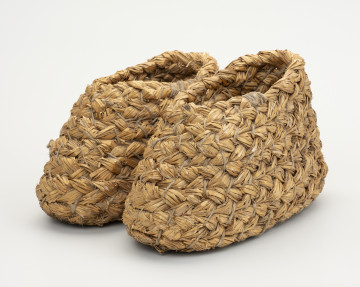
Pair of straw boots (Berloce)
1940 — 1949
National Museum in Szczecin
Part of the collection: Basketry
Shoes made of straw plaits were used as protective footwear when working on the farm during the winter. They were particularly useful when threshing grain with a flail. Furthermore, they provided comfortable warmth for a person's legs during sleigh rides. Threshing with the flail was carried out on the barn's threshing floor in winter. It was handled by men, usually working in twos, taking turns beating according to a set rhythm. It was possible to thresh about a crown of rye, or 36.5 kilograms, in a single day. This rhythmic work was sure to keep you warm even in freezing weather. However, it required prolonged standing in one place, causing the legs, especially the feet, to freeze. A straw shoe, into which the foot was fitted and secured with a thick woollen sock or a footwrap, provided excellent insulation from the cold ground and retained heat better than any leather shoe. Berloce, as they are called in some regions of Poland, were made from rye straw, the only kind suitable for products of this kind. They were woven using a simple braiding technique involving spirally building up individual rows and sewing them together with string. Typically, these were produced in the comfort of one's own household. Iwona Karwowska
Author / creator
Object type
berloce straw boots
Technique
coiling (weaving), braided weave
Material
straw, hemp string
Origin / acquisition method
donation
Creation time / dating
Creation / finding place
Owner
Muzeum Narodowe w Szczecinie
Identification number
Location / status

1940 — 1949
National Museum in Szczecin

700 — 1250
National Museum in Szczecin

circa 1980 — 1985
National Museum in Szczecin
DISCOVER this TOPIC
Museum of King Jan III's Palace at Wilanów
DISCOVER this PATH
Educational path